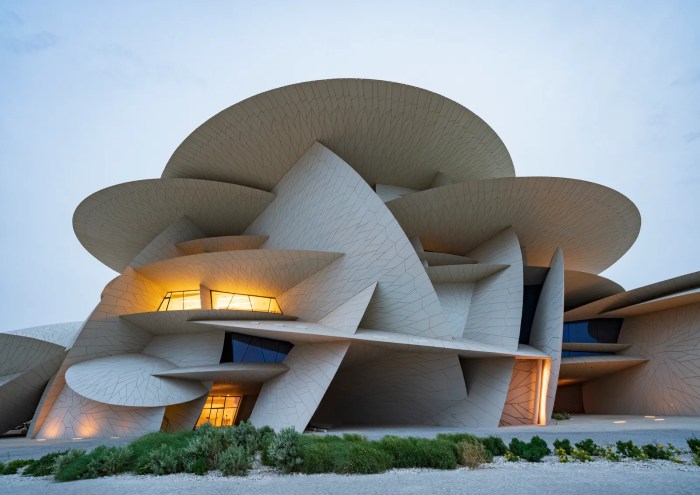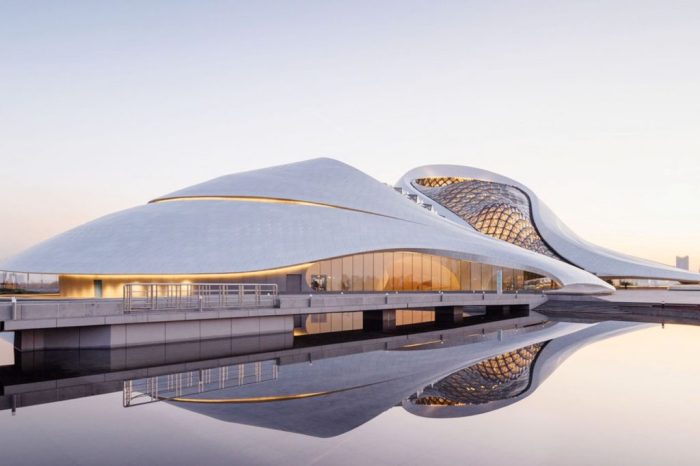Embark on a journey through time and space as we delve into the captivating world of architectural works. From towering ancient structures to sleek contemporary designs, this topic promises to unveil the artistry and innovation behind some of the world's most iconic buildings.
As we navigate through the evolution, elements, cultural influences, and urban planning aspects of architectural works, prepare to be enthralled by the rich tapestry of history, creativity, and functionality that define this fascinating field.
Overview of Architectural Works
Architectural works encompass the design, planning, and construction of buildings and structures that serve various purposes, ranging from residential homes to commercial buildings, public spaces, and cultural landmarks. Architects are responsible for creating functional and aesthetically pleasing spaces that meet the needs of individuals and communities.Architectural works play a crucial role in society by shaping the physical environment in which we live, work, and interact.
They not only provide shelter and space for activities but also influence the way we experience and perceive our surroundings. From iconic skyscrapers to historic monuments, architectural works serve as symbols of cultural identity, technological advancement, and artistic expression.
Examples of Famous Architectural Works Around the World
- The Eiffel Tower in Paris, France - an iconic landmark known for its intricate iron lattice design and engineering marvel.
- The Sydney Opera House in Australia - a UNESCO World Heritage site renowned for its distinctive sail-like roof and contribution to modern architecture.
- The Taj Mahal in Agra, India - a symbol of love and architectural masterpiece featuring intricate marble work and symmetrical design.
- The Burj Khalifa in Dubai, UAE - the tallest building in the world, showcasing innovative skyscraper design and engineering techniques.
- The Guggenheim Museum in Bilbao, Spain - a contemporary art museum designed by Frank Gehry, famous for its titanium-clad structure and unique form.
Historical Evolution of Architectural Works

The evolution of architectural styles throughout history has been heavily influenced by various factors such as cultural shifts, technological advancements, and significant historical events. These influences have shaped the way buildings are designed and constructed, leading to the diverse range of architectural works we see today.
Ancient Architectural Works
Ancient architectural works, such as the pyramids of Egypt, the Parthenon in Greece, and the Colosseum in Rome, were characterized by grandeur, symmetry, and a focus on monumental structures that reflected the power and wealth of the civilizations that built them.
These buildings often served religious, political, or social purposes and were constructed using primitive building techniques and materials.
Modern Architectural Works
In contrast, modern architectural works focus more on functionality, sustainability, and innovation in design. Buildings today are often designed to be energy-efficient, environmentally friendly, and technologically advanced. The use of new materials, such as glass, steel, and concrete, has allowed architects to create structures that were once unimaginable.
Influence of Historical Events
Historical events, such as wars, revolutions, and industrialization, have also played a significant role in shaping architectural styles. For example, the Industrial Revolution led to the development of new construction techniques and materials, resulting in the rise of skyscrapers and steel-framed buildings in the 19th century.
Comparison of Ancient and Modern Architectural Works
When comparing ancient and modern architectural works, one can see a clear shift from ornate, decorative designs to more minimalist and functional aesthetics. While ancient buildings focused on intricate detailing and craftsmanship, modern architecture embraces simplicity, clean lines, and open spaces.
Additionally, ancient structures were often built to last for centuries, while modern buildings are designed with flexibility and adaptability in mind to accommodate changing needs and technologies.
Elements of Architectural Works
Architectural works are a harmonious blend of various elements that come together to create functional and visually appealing structures. Key elements such as form, function, materials, aesthetics, space, light, sustainability, and eco-friendly practices play a crucial role in shaping architectural designs.
Form
Form in architecture refers to the overall shape and structure of a building. Architects carefully consider the form of a building to ensure it meets the functional requirements while also creating a visually pleasing design. The form can vary from simple geometric shapes to complex and innovative structures, depending on the architect's vision.
Function
Functionality is a fundamental element in architectural design. Architects must carefully consider how the building will be used and ensure that the design meets the practical needs of its occupants. This includes considerations such as spatial layout, circulation, and usability to create a space that is efficient and effective in serving its purpose.
Materials
The choice of materials in architectural works not only affects the aesthetics but also plays a significant role in the durability, sustainability, and energy efficiency of the building. Architects select materials based on their properties, such as strength, flexibility, insulation, and environmental impact, to create structures that are both visually appealing and sustainable.
Aesthetics
Aesthetics in architecture focus on the visual appeal and beauty of a building. Architects use principles of design, such as balance, proportion, rhythm, and harmony, to create visually pleasing structures that evoke emotions and engage with the surrounding environment. Aesthetics contribute to the overall quality and character of architectural works.
Space and Light
Space and light are essential elements that architects manipulate to create dynamic and functional designs. Architects use spatial organization, scale, and proportions to define different areas within a building and establish relationships between them. Light is carefully controlled and utilized to enhance the spatial experience, create ambiance, and highlight architectural features.
Sustainability and Eco-Friendly Practices
In modern architectural works, sustainability and eco-friendly practices have become increasingly important considerations. Architects incorporate green building materials, energy-efficient systems, passive design strategies, and renewable energy sources to reduce the environmental impact of buildings and promote a more sustainable future.
By integrating sustainable practices, architects play a crucial role in creating buildings that are environmentally responsible and resilient to future challenges.
Cultural Influences on Architectural Works
Cultural influences play a significant role in shaping architectural designs, reflecting the values, beliefs, and traditions of a particular society or community. These influences can be seen in various aspects of architectural works, including the choice of materials, construction techniques, decorative elements, and overall design aesthetics.
Impact of Globalization on Architectural Works
Globalization has had a profound impact on architectural works, leading to the fusion of different cultural styles and influences. Architects now have access to a wide range of design ideas and materials from around the world, allowing them to create innovative and unique structures that blend elements from various cultures.
This has resulted in the emergence of architectural styles that are truly global in nature, reflecting the interconnectedness of our modern world.
Architecture as a Reflection of Cultural Identity
Architecture serves as a powerful expression of a society's cultural identity, showcasing its history, values, and aspirations. Buildings and structures often symbolize important cultural events, beliefs, and traditions, serving as a visual representation of a community's heritage. By studying the architecture of a particular region, one can gain valuable insights into the culture and identity of its people.
Architectural Works in Urban Planning

Architectural works play a crucial role in shaping the urban landscape and influencing the development of cities. The relationship between architectural works and urban planning is intertwined, as the design of buildings and structures directly impacts the functionality, aesthetics, and overall feel of a city.
Role of Architects in Creating Sustainable and Livable Cities
Architects have a significant responsibility in creating sustainable and livable cities by incorporating environmentally friendly designs, utilizing energy-efficient materials, and promoting green spaces within urban areas. They play a key role in designing buildings that are not only visually appealing but also contribute to the well-being of the community.
Examples of Innovative Architectural Designs
- The High Line in New York City: This elevated linear park built on a historic freight rail line showcases innovative urban design by transforming an unused space into a vibrant public park.
- Bosco Verticale in Milan, Italy: These vertical forests consist of residential towers covered in vegetation, providing a green oasis in the midst of a bustling city and promoting biodiversity.
- Singapore's Marina Bay Sands: This iconic integrated resort features a unique architectural design that has become a symbol of modern urban development, combining luxury, sustainability, and entertainment.
Final Thoughts
In conclusion, architectural works stand as testaments to human ingenuity and creativity, shaping our landscapes and reflecting our values and aspirations. Whether ancient or modern, these structures continue to inspire awe and admiration, reminding us of the power of architecture to transcend time and leave a lasting impact on society.
FAQ Resource
What defines architectural works?
Architectural works encompass a wide range of structures, including buildings, monuments, and landmarks, designed by architects to serve functional and aesthetic purposes.
How do historical events influence architectural works?
Historical events like wars, cultural shifts, and technological advancements often impact architectural styles, materials used, and the overall design of structures.
Why is sustainability important in modern architectural works?
Sustainability ensures that architectural designs minimize negative environmental impact, promote energy efficiency, and support long-term ecological balance.













